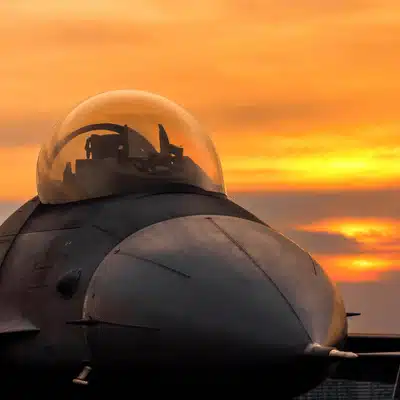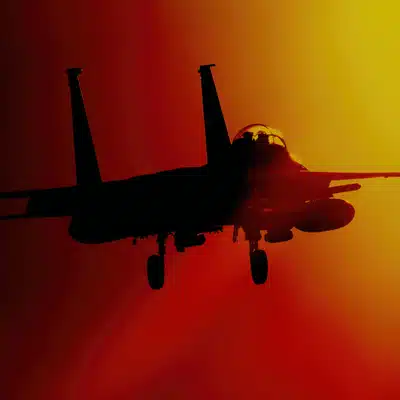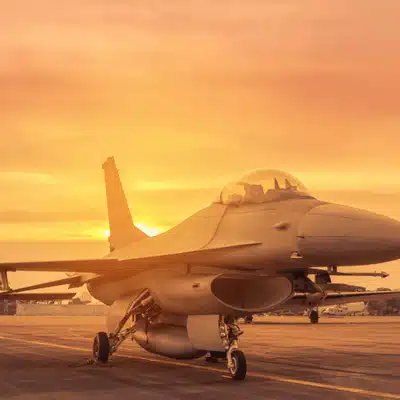Modern military aviation changed forever with night vision systems. For military pilots, night vision goggles enable combat in total darkness with confidence once unthinkable, giving air force crews new reach safely.
Night vision goggles and advanced sensors turn darkest nights into operational settings, boosting situational awareness. They help air force pilots locate enemy targets, navigate, and dominate at night, strengthening military effectiveness in night warfare, combat surveillance and strikes.
How Aviation Night Vision Systems Work

Night vision devices function as starlight amplifiers. They collect tiny amounts of light from stars, moon, and distant light sources. The system then boosts this light thousands of times to create visible images.
Most aviation NVG systems use image intensifier tubes. These tubes convert incoming light into electrons through a photocathode. The electrons multiply through a microchannel plate. Finally, a phosphor screen converts them back into visible light.
This image enhancement process creates the green glow pilots see through their goggles. The result gives aircraft crews artificial vision in illumination conditions that would normally ground aviation operations.
Modern military systems also include infrared mode capabilities. Night vision camera sensors detect heat signatures from engines, vehicles, and personnel. This thermal imaging works even when zero ambient light exists.
Aircraft combine both technologies. Pilots wear helmet-mounted NVG while aircraft carry thermal targeting pods. This dual approach maximizes detection during combat operations.
Evolution Through Night Vision Generations
Night vision technology has advanced through several distinct generations. Each upgrade brought major improvements in performance and reliability.
Generation 1 devices from the 1960s used basic light amplification. These early night vision scopes had poor resolution and limited range. They worked but barely met military standards.
Generation 2 systems added improvements in the 1970s. This innovation greatly improved image brightness and clarity. Air force pilots could finally rely on consistent performance during night operations.
Generation 3 became the military standard by the 1980s. These night vision devices use gallium arsenide photocathodes for superior sensitivity. They also include auto-gating to handle sudden bright flashes from explosions or flares.
Today’s Generation 4 systems remove the ion barrier film entirely. This technology advancements provides better resolution and reduces blooming from bright lights. Pilots get clearer images in extremely dark conditions with less interference.
Fighter Jet Integration and Tactical Uses

Installing night vision components in fighter jets demands cockpit design. Instrument lighting must be NVG compatible to avoid glare blinding night vision devices, including goggles.
Pilots mount night vision goggles on flight helmets, often using AN/AVS-9 for sharp imagery. They flip the optics up quickly to check instruments, a routine common across air force squadrons.
Night formation flying shows tactical advantages. Aircraft use infrared position lights invisible to eyes, allowing air force squadrons to coordinate in darkness while night vision devices maintain stealth, control, spacing.
The field of view through standard goggles covers about 40 degrees. While narrower than normal vision, this provides enough visibility for critical tasks. Pilots learn scanning techniques to compensate for the limited viewing area.
Target identification becomes much easier with NVG. Pilots spot aircraft exhaust glow from dozens of miles away. They can also see laser designators and infrared pointers for coordinated targeting between aviation units.
Low-level terrain following represents another crucial capability. Night flights through mountainous areas require precise navigation to avoid controlled flight into terrain. NVG helps pilots identify terrain features like ridges and valleys that disappear in darkness.
Key Advantages for Combat Aviation
Enhanced situational awareness stands as the primary benefit. Pilots see their surroundings clearly instead of flying blind in darkness. This visibility improvement directly increases pilot safety during all night operations.
Navigation becomes far more precise with visual ground references. Pilots identify landmarks, obstacles, and weather conditions from greater distances. This early warning gives more time to react and adjust flight paths safely.
Combat capabilities expand dramatically with night vision devices. Military units now conduct 24-hour operations instead of being limited to daylight missions. This operational flexibility provides major strategic advantages.
Reconnaissance missions gain new effectiveness in darkness. Pilots observe enemy movements, vehicle positions, and facility activities without detection. Aviation crews reveal details invisible to opponents during night warfare.
Precision targeting improves significantly during combat missions. Pilots confirm targets visually before engaging, reducing civilian casualties and friendly fire incidents. The combination of NVG and laser designators enables accurate strikes in total darkness.
Pilot confidence increases when flying dangerous flight missions at night. Restoring natural vision cues reduces stress and pilot fatigue. This psychological benefit helps maintain performance during long combat missions.
Overcoming Night Vision System Limitations
Night vision goggles face several challenges that ongoing development addresses. Understanding these limitations helps pilots maximize system effectiveness.
The restricted viewing angle can create tunnel vision effects. Pilots compensate through continuous head movement and systematic scanning patterns. New panoramic systems with multiple tubes offer wider coverage across aviation platforms.
Depth perception changes when viewing 2D NVG images. Distance judgment becomes more difficult during tasks like aerial refueling. Extensive pilot training teaches techniques to interpret visual cues correctly.
Bright lights cause temporary blooming that can blind pilots momentarily. Auto-gating technology in modern systems rapidly adjusts brightness to minimize this problem. Pilots also learn to avoid looking directly at explosions or flares from light sources.
Added helmet weight from NVG units increases stress over long missions. Lighter materials and better weight distribution help reduce this issue. Some aircraft integrate night vision directly into visors to eliminate separate goggle units.
Proper training remains essential for safe NVG operations. Military programs teach transition techniques, scanning methods, and emergency procedures. Regular practice maintains proficiency and reduces safety risks across all aviation disciplines.
Advanced Systems on the Horizon
Next-generation night vision system designs promise even greater capabilities. Aviation continues advancing through integrated approaches that eliminate separate goggle units entirely.
Sensor fusion combines multiple imaging types into single displays. Pilots receive both light-amplified and thermal images simultaneously through infrared mode switching. This approach reveals camouflaged targets while maintaining detail visibility.
Digital night vision imaging systems may eventually replace analog tubes. These systems offer customizable displays and augmented reality overlays. Navigation systems integration could project waypoints and threat warnings directly onto pilot visors.
Artificial intelligence assistance represents another frontier. Smart systems might automatically highlight threats or obstacles in NVG displays. This technology could reduce workload while improving threat detection during aviation missions.
Wider viewing areas continue improving through multi-tube designs. Some experimental systems provide nearly natural human vision coverage. These advances reduce the scanning requirements that increase pilot workload across military aviation operations.
Air force units worldwide invest heavily in these emerging technologies. The goal remains giving pilots maximum situational awareness during the most challenging night flights possible.
Take Action: Upgrade Your Night Vision Capabilities

Modern aviation demands the most advanced night vision system available. Don’t let outdated equipment limit your operational effectiveness or compromise pilot safety.
Contact our aviation night vision specialists today. We provide comprehensive training programs, equipment assessments, and technology upgrades for military units worldwide. Our expertise ensures your pilots have the visibility advantage they need for successful operations and combat missions.
Frequently Asked Questions
How do night vision goggles work for aviation operations? NVG systems amplify available starlight and moonlight thousands of times through electronic image intensifier tubes. This process converts minimal light into clear green images that allow pilots to see terrain features, other aircraft, and threats in total darkness during aviation missions.
What are the main advantages of night vision optics in military aviation? Night vision provides enhanced situational awareness, safer navigation through terrain features, expanded 24-hour combat capabilities, and improved accuracy. These advantages allow air force units to conduct effective operations that were previously impossible during aviation missions.
What challenges do pilots face when using these systems? The main limitations include restricted viewing angles, altered depth perception, potential glare, and increased weight causing fatigue. Proper training and advancing technology continue to minimize these risks during military aviation operations.
How has technology evolved for modern aircraft systems? Systems have progressed from basic amplifiers to today’s advanced units with filmless tubes and auto-gating. Modern aircraft integrate thermal imaging, sensor fusion, and displays that eliminate separate goggle units entirely for improved safety across aviation platforms.

